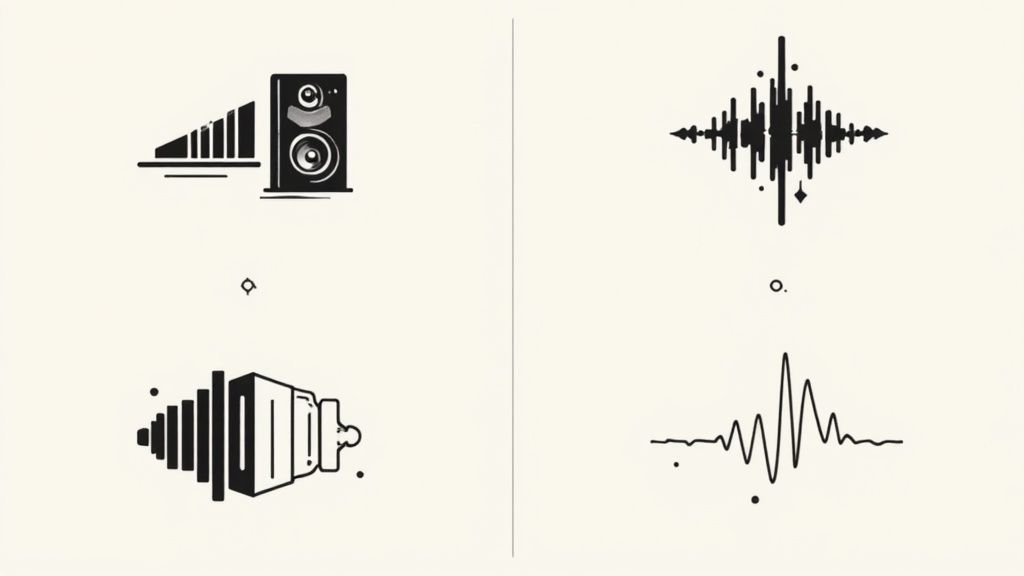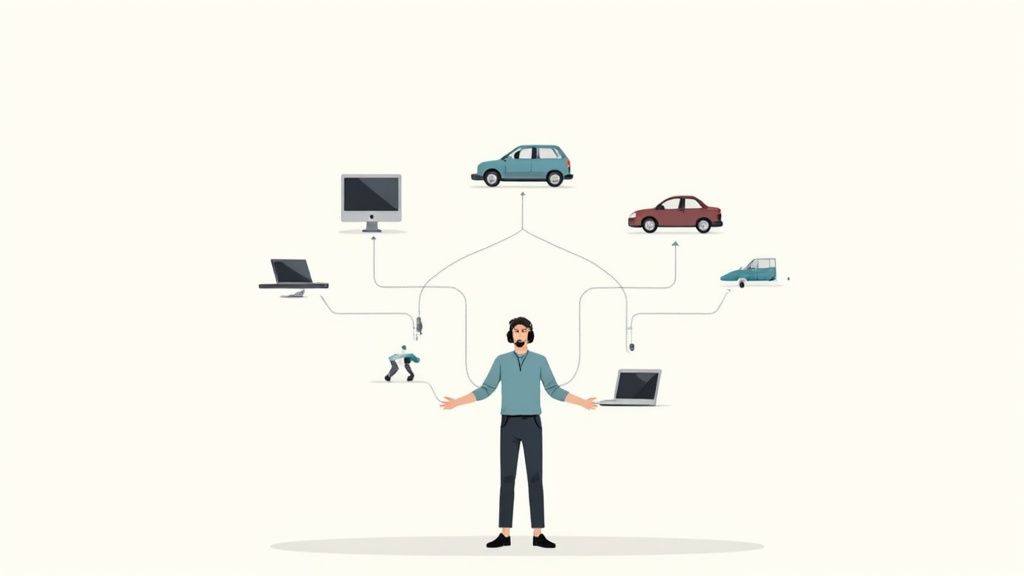So, what exactly is online mastering? Think of it as the final, essential polish that takes your finished mix and gets it ready for the world. It’s a lot like a professional photographer editing a raw photo—the process enhances clarity, boosts the overall impact, and makes sure your music sounds incredible on every possible device.
For independent artists trying to make their mark on streaming services, this step isn't just nice to have; it's absolutely critical.
You’ve poured everything into writing, recording, and mixing your track. In your studio, it sounds perfect. But how will it translate to a car stereo, cheap earbuds, or a massive club sound system? That’s where the magic of mastering comes in. It’s the final quality check that ensures your music truly connects with listeners, no matter where they are.
Mastering is what closes the gap between a solid bedroom production and a commercially competitive release. It’s not about changing the soul of your song—it's about bringing out its absolute best by tackling subtle but crucial details that separate the pros from the amateurs.
Let's use an analogy. Your mix is a collection of amazing, high-quality ingredients for a cake. Mastering is the final bake. It blends everything together perfectly, gets the texture just right, and adds that final layer of icing that makes it impossible to resist.
Here’s a look at the key transformations your track goes through during this final stage:
Before we dive into the details, this table gives a quick snapshot of what mastering really does to a track.
Mastering is that last 10% of the production work that delivers 90% of the commercial polish. It’s the step that makes a song truly feel "finished."
And thanks to online services, this crucial step is more accessible than ever. The music mastering market was valued at a cool $0.82 billion and is on track to nearly double by 2033. Online platforms are leading the charge, now making up over 42% of all mastering revenue.
Ultimately, if you want your tracks to stand a chance, professional mastering is a must—especially when it comes to marketing music effectively on YouTube and other crowded platforms. It levels the playing field, giving you the power to release music that sounds just as clean and polished as anything coming from a major label.
So, your track is mixed and you're ready for that final polish. When it comes to online mastering, you’ve basically got two roads you can go down. Think of it like this: are you hopping in a sleek, self-driving car or hiring a seasoned chauffeur? Both get you where you need to go, but the journey—and the final result—are totally different.
The first road is AI mastering. Picture a super-smart system that's crunched the data on literally millions of hit songs. It analyzes your track's DNA and applies processing based on what it learned from all those commercially successful records. It’s a powerful approach, and for good reason.
For the bedroom producer grinding away or the artist who needed their track done yesterday, AI mastering is a lifesaver. It really boils down to three things: speed, cost, and consistency.
This isn't just a niche thing, either. The tech is blowing up. Data shows that 36.8% of music producers are already using AI in their workflow. And the market for AI music tools is expected to rocket from $3.9 billion to a staggering $38.7 billion by 2033. You can check out more stats on AI in the music industry to see just how fast this train is moving.
The other path is bringing a human mastering engineer on board. This is your chauffeur—an expert who has spent years honing their craft, training their ears, and developing a gut feeling for what makes a track connect emotionally. A human brings something to the table that code just can't replicate: creative judgment.
A human engineer doesn’t just hear frequencies; they feel the song’s intention. They pick up on the subtle crack in a singer's voice or the push and pull of a bassline, and they make choices to amplify that unique human element.
When you work with a person, it becomes a collaboration. You can send them reference tracks, give feedback, and have a real conversation about your vision. That human touch is priceless for the big stuff—your debut album, that make-or-break single—where every little detail matters. If you want to get a better sense of their world, we've got a guide on what a mastering engineer actually does.
To make it simple, check out this infographic. It can help you figure out which route makes the most sense for your current project.

Here's a more direct look at how they stack up.
Choosing between an algorithm and an artisan can feel tough, but it's really about matching the tool to the job. This table breaks down the core differences to help you decide what's right for your track, right now.
At the end of the day, there's no single "better" option. AI is an incredible tool when your priorities are speed and budget. But when your music needs that unquantifiable human element and creative partnership, nothing beats the experience of a real engineer. The best choice is the one that gets your music sounding the way you heard it in your head.

So you've just gotten a master back from an online service. What are you actually supposed to be listening for? Sure, it "sounds better," but knowing why it sounds better is the key to giving good feedback and getting a final track that truly slaps.
Think of mastering as the final quality control check before your music goes out into the world. It’s not about changing the song itself, but about polishing specific technical elements so your track feels professional and translates everywhere—from AirPods to a club system. This polish is what keeps listeners locked in and is a huge piece of the puzzle for how audio choices affect viewer retention on platforms like TikTok.
One of the first things you'll hear is the volume jump. But modern mastering isn't just a volume knob crank. It’s a delicate balancing act to achieve a competitive loudness on streaming platforms while keeping the song's energy and emotion—its dynamic range—intact. We measure this in LUFS (Loudness Units Full Scale).
Imagine you're at a crowded party. You need to speak loud enough to be heard over the chatter, but you don't want to be the one person screaming in everyone's ear. That's what mastering does. It finds that perfect level for your track—punchy and present, but not so squashed that all the life gets squeezed out of it. A good master still breathes.
Next, close your eyes and listen to the space. Stereo imaging is all about creating the three-dimensional world your music exists in. A killer master can take a mix that feels a little cramped or stuck in the middle and open it up into a wide, immersive soundscape.
Think of it like this: your mix is a painting on a canvas. Mastering is what stretches that canvas, giving every single instrument its own little spot to shine.
When you're listening, ask yourself:
This is what makes your song sound just as good on a great pair of headphones as it does blasting from studio monitors.
Tonal balance is just a fancy term for how the bass, mids, and treble all play together. The goal here is a smooth, cohesive sound where no single frequency range is screaming for attention over the others. It should just feel right.
A well-mastered track is like a perfectly cooked meal. Nothing is too salty (harsh highs), too heavy (muddy lows), or bland. Every flavor works together to create something delicious.
When you get your preview, listen for the common problems that mastering cleans up. Is the low end tight and powerful, or is it a boomy mess? Are the vocals crisp and clear, or are they harsh and sibilant? The whole track should feel glued together. If you want to see the tools that make this happen, check out our breakdown of a typical audio mastering chain.
Alright, last one, and it's a bit technical but super important: phase coherency. This is the ultimate compatibility test. It ensures your track doesn't fall apart when it gets played on a mono system—like your phone's speaker, a portable Bluetooth speaker, or a massive club PA system.
When a stereo track is collapsed to mono, any out-of-phase sounds can literally cancel each other out. Your kick drum could lose its punch, or the bass could just... disappear. It's a real problem.
Mastering engineers use special tools to spot and fix these phase issues, making sure the foundation of your track stays solid and punchy, no matter where it’s being played. It’s the final check that guarantees your music hits hard everywhere.
Think of it this way: your mix is the cake, and mastering is the icing. You can have the most incredible frosting, but if the cake underneath is burnt or crumbly, it's just not going to work. Giving your mastering engineer—or the AI—the best possible ingredients is absolutely key.
This quick pre-flight check will stop you from making the common mistakes that can tank a final master, saving you from the headache of re-exporting everything. Trust me, a few minutes now saves hours of pain later.
This is the big one. The most important rule, hands down, is to avoid clipping. Your final mix file should have zero digital distortion. A good rule ofthumb is to make sure the loudest parts of your song never peak above -6dBFS on your master fader.
That empty space at the top is called headroom, and it’s the playground for mastering. It gives the process the room it needs to apply EQ, compression, and other goodies without cramming everything into a distorted mess. The job of making your track loud belongs to mastering, not mixing.
Your mix needs to sound good on its own, without a bunch of "pre-mastering" plugins slapped on the main output. Before you bounce the track, bypass or remove any processors you have sitting on your master bus.
I'm talking about:
The only real exception is if you have a bus compressor or EQ that you've been mixing into from the very beginning. If it’s providing that essential "glue" and is part of the track's DNA, you can leave it on. If you just threw it on at the end, kill it.
Sending a mix with a limiter is like giving a painter a canvas that's already been varnished. The mastering engineer needs a clean, dynamic file to work with, not something that's already been squashed flat.
Last but not least, the file format you choose is critical. Never, ever send an MP3 or any other compressed file for mastering. These formats literally throw away audio information to shrink the file size, and you can never get that data back.
For the best possible results, you need to export a high-resolution, lossless file. Just stick to these specs and you'll be golden:
Follow these simple steps, and you’ll be handing over a clean, dynamic, and high-quality file. It’s the perfect setup for any online mastering service to deliver a polished, professional track that’s ready for release.

Okay, you got your mastered track back. This is the moment of truth. Before you pop the champagne, you need to put that file through its paces to make sure it's actually ready for the world. A real review isn’t just about blasting it on your fancy studio monitors—it's about making sure your music translates everywhere.
The whole point of professional online mastering music is to get your song sounding competitive, whether it’s on a massive club system or a pair of cheap earbuds. This final step is non-negotiable. With the global music streaming market hitting $46.66 billion and on track to more than double by 2030, a pro-level master is your ticket to even stand a chance.
To really evaluate your master, you need a system. Don't just listen for what you like; listen for specific changes and potential problems. The first step is to set up a controlled A/B test between your original mix and the new master.
But first, you have to level-match them. This is crucial. Your new master will be louder, and our brains are hardwired to think louder is better. Drop the master's volume until it feels just as loud as your original mix. Now you can actually compare them fairly.
Your studio is a bubble. The real test is how your music survives in the wild on all the different systems people actually use. A great master should feel consistent and hit hard no matter where it's played.
The car stereo is often called the "second studio" for a reason—it’s where a ton of people do their most serious listening. If your master turns to mud, gets harsh, or loses its punch in the car, that’s a massive red flag.
Set up a listening circuit and hit these key systems:
As you listen, you’re looking for improvements in punch, clarity, and width. For a deeper dive into what loudness targets to shoot for, check out our full guide on audio mastering levels. Taking the time to properly vet your master is what separates the amateurs from the pros—it ensures your music connects with every listener, everywhere.
Jumping into online mastering can feel like navigating a minefield of new terms and conflicting advice, especially when you're just starting out. Getting straight answers is the only way to feel good about the choices you make for your music.
Let's cut through the noise. Here are the real answers to the questions producers and artists ask most.
This is the big one, and the answer is a hard no. Mastering is the final coat of polish, not a miracle cure for a broken mix.
Think of it this way: mixing is like building the car from the ground up—welding the frame, dropping in the engine, getting all the parts to work together. Mastering is the high-end paint job, the detailing, and the final inspection before it hits the showroom floor. If the engine is knocking and the wheels are crooked (a bad mix with a muddy low end or vocals that disappear), a glossy paint job isn't going to make it drive any better.
Mastering can make a great mix sound incredible. It can add punch, width, and that commercial loudness everyone's after. But it can’t reach back in time to separate a kick drum that’s glued to the bassline or fix harsh frequencies in your cymbals.
Key Takeaway: Mastering is only as good as the mix you feed it. Your job is to get your mix sounding as close to perfect as you possibly can before you even think about sending it off for mastering.
Good news: the loudness wars are basically over. In the past, everyone tried to make their track louder than the next guy's. Today, streaming giants like Spotify and Apple Music have put an end to that. They use something called loudness normalization.
This means every track on the platform gets adjusted to a standard playback level, which is roughly -14 LUFS (Loudness Units Full Scale).
If you upload a brick-walled, ultra-loud master, the platform is just going to turn it down. Chasing that extreme volume usually means crushing all the life and dynamics out of your track with a limiter, which ironically makes it sound weak and flat once it's normalized. The goal now isn't just volume; it's creating a dynamic, punchy master that feels powerful without being squashed.
Focus on clarity and impact. Aiming for a loudness level somewhere between -14 LUFS and -9 LUFS gives you a competitive master that will translate beautifully after the streaming services work their magic.
It absolutely can be—it just depends on the project and what you're trying to accomplish. AI mastering isn't a replacement for a human engineer, but it's a ridiculously powerful tool for the modern musician.
This is a great question, and knowing the difference can seriously level up your sound. It all comes down to how much control you want to give the mastering process.
Stereo Mastering: This is the classic method. You bounce your final mix down to a single stereo file (like a WAV) and send that one file to be mastered. The engineer works their magic on the entire track as a whole.
Stem Mastering: This is a more surgical approach. Instead of one file, you export your mix into a handful of grouped tracks, or "stems." For example, you might have a stem for drums, one for bass, one for vocals, and another for all the synths and guitars. This gives the engineer way more control to fine-tune the balance between the elements, like adding extra punch to just the drums without affecting the vocal. It’s a bigger investment, but the results can be incredibly detailed.
Ready to hear what a professional master can do for your track? CarMaster gives you a free, instant preview of your song, specifically tuned to sound amazing in the car—where most people listen—while still sounding perfect everywhere else. Stop guessing and protect your music. Try it now at https://www.carmaster.io.